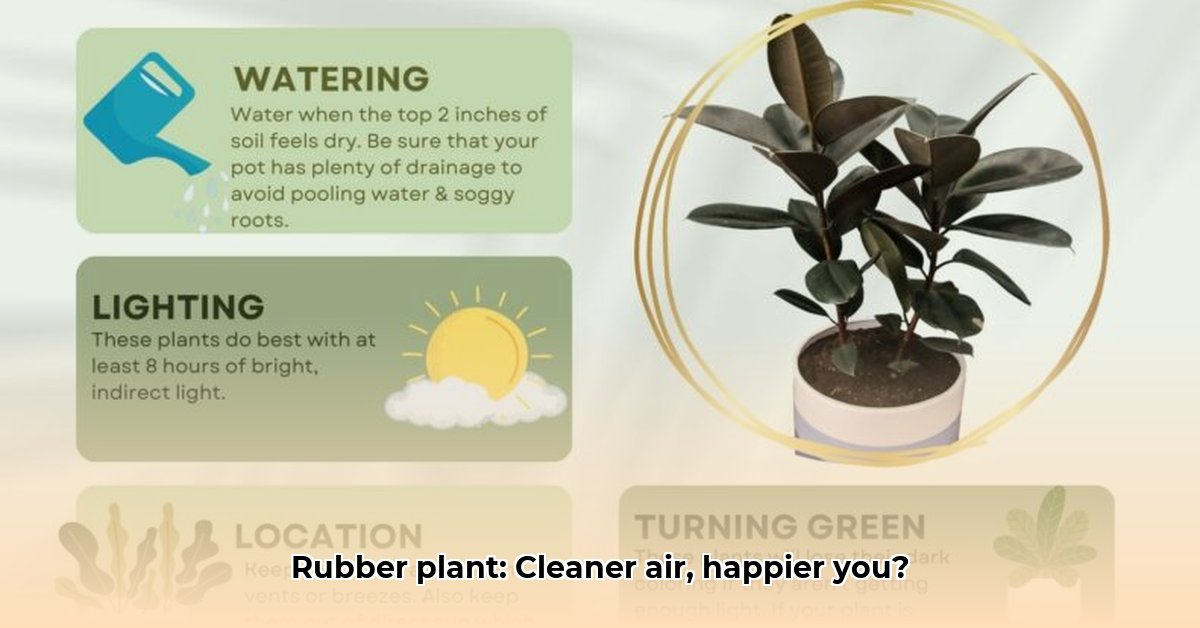
Benefits of the Rubber Plant (Ficus elastica)
Rubber plants are gaining popularity as stylish and surprisingly beneficial houseplants. Their glossy leaves and relative ease of care make them a fantastic addition to any home or office, offering several key advantages.
Air Purification: A Natural Air Filter
The rubber plant's large leaves have been studied for their potential to remove airborne toxins. The NASA Clean Air Study, while not conclusive on exact quantities, suggests that Ficus elastica can remove certain volatile organic compounds (VOCs), including formaldehyde and benzene. While this shouldn't replace proper ventilation, it contributes to a healthier indoor environment. Further research is ongoing to fully quantify the effect. Do you find yourself wondering how much cleaner your air could be with just one rubber plant?
Aesthetic Appeal: Enhancing Your Space
Beyond air purification, the rubber plant offers undeniable aesthetic appeal. Its rich, dark green leaves provide a touch of elegance. Many varieties also boast variegated foliage—striking splashes of pink, red, or cream against the deep green—adding visual interest to any space. The rubber plant's striking appearance enhances any style of house décor and can be used as a focal point or a subtle addition to your rooms. How would one of these beauties improve the look of your living room?
Ease of Care: A Beginner-Friendly Plant
One of the rubber plant's biggest selling points is its low-maintenance care. Even those with limited plant-care experience can easily maintain these plants.
- Watering: Allow the top inch or two of soil to dry completely before watering thoroughly. Avoid overwatering; soggy soil is detrimental.
- Lighting: Bright, indirect light is best. Direct sunlight can scorch leaves, so place your plant near a window but avoid direct exposure.
- Fertilizing: Feed your plant sparingly, once a month during spring and summer, using a balanced, diluted liquid fertilizer. Reduce or eliminate fertilizing during the winter months.
- Humidity: While not essential, increased humidity can promote better growth. Considering grouping your plants or using a humidifier.
Psychological Benefits: A Calming Presence
The presence of plants is often associated with feelings of calmness and reduced stress. While more research is needed to specifically link rubber plants to mood improvement, the simple act of caring for a living thing may contribute to well-being. The visual appeal of the lush foliage provides a natural element that adds to the serene atmosphere. Wouldn’t it be fascinating to investigate which elements of nature have the most potent stress-relieving effects?
Cultivation and Propagation: Growing Your Rubber Plant Collection
The rubber plant is surprisingly easy to propagate, allowing you to expand your collection and share the benefits with others.
- Taking a Cutting: Select a healthy 4-6-inch stem cutting, cutting just below a leaf node.
- Preparing the Cutting: Remove the lower leaves to encourage root growth.
- Rooting: Place the cutting in well-draining potting mix or a glass of water, keeping the soil or water consistently moist. Using rooting hormone is beneficial but not essential. Root development takes several weeks.
- Planting the Cutting: Once roots are established (after about 2-3 weeks), plant your propagated rubber plant in its own small pot, ensuring excellent drainage.
Repotting and Transplanting: Providing Ample Space
As your rubber plant grows, it may require repotting into a larger pot to accommodate its expanding root system. This is usually necessary when roots begin to circle the bottom of the pot. Choose a pot only slightly larger than the previous one.
Troubleshooting: Addressing Common Problems
- Leaf Drop: Adjust watering schedule; ensure consistent temperature and humidity. Avoid sudden temperature changes.
- Yellowing Leaves: Improve drainage; use well-draining soil; fertilize sparingly. Overwatering is a common cause.
- Pest Infestations: Inspect regularly for pests like mealybugs or spider mites. Treat with insecticidal soap or neem oil as needed.
Conclusion: Embrace the Benefits of the Rubber Plant
Adding a rubber plant to your home or office offers a multitude of benefits—from cleaner air and a more aesthetically pleasing environment to the potential for stress reduction. Its ease of care makes it an ideal plant for beginners and busy individuals alike. Start enjoying the benefits of a thriving rubber plant today!